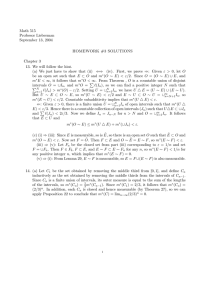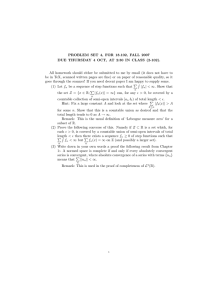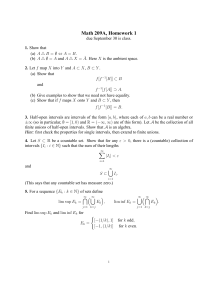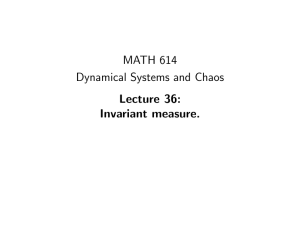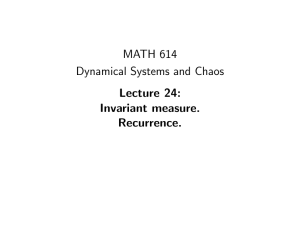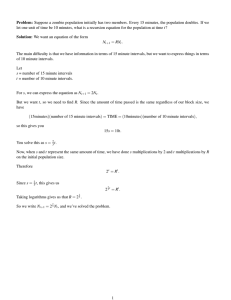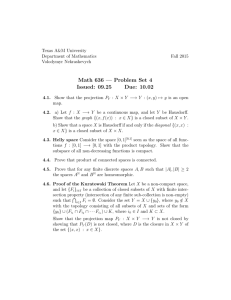Chapter 2. Length measure on R
advertisement
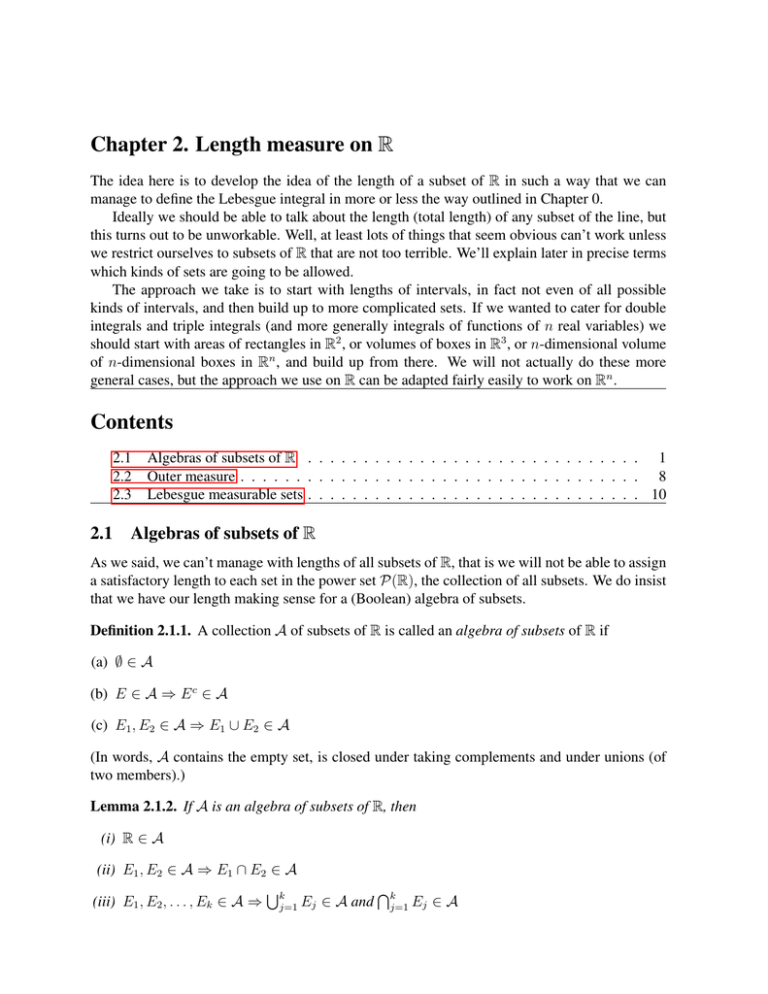
Chapter 2. Length measure on R
The idea here is to develop the idea of the length of a subset of R in such a way that we can
manage to define the Lebesgue integral in more or less the way outlined in Chapter 0.
Ideally we should be able to talk about the length (total length) of any subset of the line, but
this turns out to be unworkable. Well, at least lots of things that seem obvious can’t work unless
we restrict ourselves to subsets of R that are not too terrible. We’ll explain later in precise terms
which kinds of sets are going to be allowed.
The approach we take is to start with lengths of intervals, in fact not even of all possible
kinds of intervals, and then build up to more complicated sets. If we wanted to cater for double
integrals and triple integrals (and more generally integrals of functions of n real variables) we
should start with areas of rectangles in R2 , or volumes of boxes in R3 , or n-dimensional volume
of n-dimensional boxes in Rn , and build up from there. We will not actually do these more
general cases, but the approach we use on R can be adapted fairly easily to work on Rn .
Contents
2.1
2.2
2.3
2.1
Algebras of subsets of R . . . . . . . . . . . . . . . . . . . . . . . . . . . . . . 1
Outer measure . . . . . . . . . . . . . . . . . . . . . . . . . . . . . . . . . . . . 8
Lebesgue measurable sets . . . . . . . . . . . . . . . . . . . . . . . . . . . . . . 10
Algebras of subsets of R
As we said, we can’t manage with lengths of all subsets of R, that is we will not be able to assign
a satisfactory length to each set in the power set P(R), the collection of all subsets. We do insist
that we have our length making sense for a (Boolean) algebra of subsets.
Definition 2.1.1. A collection A of subsets of R is called an algebra of subsets of R if
(a) ∅ ∈ A
(b) E ∈ A ⇒ E c ∈ A
(c) E1 , E2 ∈ A ⇒ E1 ∪ E2 ∈ A
(In words, A contains the empty set, is closed under taking complements and under unions (of
two members).)
Lemma 2.1.2. If A is an algebra of subsets of R, then
(i) R ∈ A
(ii) E1 , E2 ∈ A ⇒ E1 ∩ E2 ∈ A
S
T
(iii) E1 , E2 , . . . , Ek ∈ A ⇒ kj=1 Ej ∈ A and kj=1 Ej ∈ A
2
Proof.
2014–15 Mathematics MA2224
(i) R = ∅c ∈ A by Definition 2.1.1 (a) and (b).
(ii) E1 , E2 ∈ A ⇒ E1 ∩ E2 = (E1c ∪ E2c )c (by De Morgans laws) ⇒ E1 ∩ E2 ∈ A (because
from Definition 2.1.1 (b) we have E1c , E2c ∈ A, thus E1c ∪ E2c ∈ A by Definition 2.1.1 (c),
and so (E1c ∪ E2c )c ∈ A by Definition 2.1.1 (b) again).
S
S
k
(iii) This follows by induction on k since k+1
E
=
E
j=1 j
j=1 j ∪ Ek , and similarly for intersections.
Definition 2.1.3. We define the interval algebra I to be the collection of all finite unions of
intervals of one of the types
(a, b], (−∞, b], (a, ∞), (−∞, ∞)
We include the empty set in I (as the union of the empty collection of such intervals!).
(So the right hand end point is included in these intervals when it is finite and the left-hand
end point is not included.)
Lemma 2.1.4. I is an algebra (of subsets of R).
Proof. This is almost obvious, but a formal check is perhaps
a good idea.SIf we take the union
Sn
0
of two members of I , say of two finite unions E1 = j=1 Ij and E2 = m
k=1 Ik (where the Ij
0
and Ik are intervals of the allowed types), then
E1 ∪ E2 =
n
[
Ij ∪
j=1
m
[
Ik0
k=1
is again a finite union of intervals and so E1 ∪ E2 ∈ I .
Considering the intersection E1 ∩ E2 (instead of the union) we have
E1 ∩ E2 =
n
[
(Ij ∩ E2 ) =
j=1
n [
m
[
(Ij ∩ Ik0 )
j=1 k=1
and to see that E1 ∩ E2 ∈ I notice that each Ij ∩ Ij0 is either empty or another interval of the
same type. By induction, we have then that finite intersections of sets in I will be in I .
The complement of one of the intervals we are allowing is either another of these intervals or
the union of two such. For instance
(a, b]c = (−∞, a] ∪ (b, ∞), and (−∞, b]c = (b, ∞).
S
By De Morgans laws then, if E ∈ I with E = nj=1 Ij , we have
Ec =
n
\
Ijc
j=1
and we have just noted that each Ijc ∈ I . So E c ∈ I (using what we just showed about finite
intersections).
Length measure
3
Remark 2.1.5. One thing to note is that if two intervals of the types above overlap or share an
endpoint, then their union is another interval of the same kind.
So we can write every set in I uniquely as one of the following
∅, R,
(a1 , b1 ] ∪ (a2 , b2 ] ∪ · · · ∪ (an , bn ],
(−∞, b1 ] ∪ (a2 , b2 ] ∪ · · · ∪ (an , bn ],
(a1 , b1 ] ∪ (a2 , b2 ] ∪ · · · ∪ (an , ∞), or
(−∞, b1 ] ∪ (a2 , b2 ] ∪ · · · ∪ (an , ∞),
where
a1 < b1 < a2 < b2 < · · · an < bn .
Remark 2.1.6. We want to define a length function on subsets of R, certainly including the sets
in I for a start. But some of the intervals above have infinite length and so we are led to allow
∞ as a possible length.
That means we introduce an extended system of nonnegative numbers by adding an extra
symbol ∞ to the usual [0, ∞). We regard ∞ as bigger than every ordinary x ∈ [0, ∞), that is we
extend the definition of x1 < x2 for x1 , x2 ≥ 0 to have x < ∞ for all x ∈ [0, ∞). Then we have
[0, ∞] including ∞.
We will also want to allow most arithmetic operations to be done where ∞ is allowed. So we
will extend the definition of addition and multiplication of positive numbers so that
x+∞=∞+x=∞+∞=∞
x∞ = ∞x = ∞∞ = ∞
(0 ≤ x < ∞),
(0 < x < ∞),
0∞ = ∞0 = 0
and sometimes we will have subtraction (mostly where we end up with a positive result) but we
will not define ∞ − ∞.
So we will have ∞ − x = ∞ for 0 ≤ x < ∞.
We could go further and also introduce −∞ (smaller than all x ∈ R) and then get an extended
real line [−∞, ∞], but we will not really need that (for now).
Note that the rule 0∞ = ∞0 = 0 is not always good to allow, for instance in the case of
limits, but it will be appropriate in the ways that we will encounter it for integration.
Definition 2.1.7. We define a length function (or ‘measure’) m : I → [0, ∞] by taking
m((a, b]) = b − a,
m((−∞, b]) = m((a, ∞)) = m((−∞, ∞)) = ∞
and defining m(E) for general E ∈ I as the sum of the lengths of the intervals in the unique
representation mentioned above in Remark 2.1.5.
4
2014–15 Mathematics MA2224
Terminology 2.1.8. We say that a function m : A → [0, ∞] is finitely additive if whenever
E1 , E2 , . . . , En ∈ A are disjoint (that is Ej ∩ Ek = ∅ for j 6= k), then
m(E1 ∪ E2 ∪ · · · ∪ En ) = m(E1 ) + m(E2 ) + · · · + m(En ).
By induction, to check finite additivity we only need to check it for n = 2.
We say that m is finitely subadditive if whenever E1 , E2 , . . . , En ∈ A, then
m(E1 ∪ E2 ∪ · · · ∪ En ) ≤ m(E1 ) + m(E2 ) + · · · + m(En ).
Again the case n = 2 implies the general case.
Lemma 2.1.9. The length function m we have defined on I has the properties
(i) E1 , E2 ∈ I , E1 ∩ E2 = ∅ ⇒ m(E1 ∪ E2 ) = m(E1 ) + m(E2 ) (which implies finite
additivity);
(ii) E1 , E2 ∈ I , E1 ⊆ E2 ⇒ m(E1 ) ≤ m(E2 ) (monotonicity);
(iii) m is finitely subadditive.
Proof. Most of this is quite easy, almost obvious perhaps, but maybe not so easy to organise into
a proper proof.
(i) It is sufficient to establish this in the case when E1 ∪ E2 is an interval. TheSreason is this.
We know E1 ∪ E2 ∈ I and so we can write it in the form E1 ∪ E2 = nj=1 Ij where
the Ij are intervals of the allowed types and share no endpoints — that is we are taking
E1 ∪ E2 represented in the form considered in Remark 2.1.5. Since E1 ⊆ E1 ∪ E2 , it must
be that when we write E1 in the form we mentioned in Remark 2.1.5, then the intervals
used
intervals Ij . So it is clear then that m(E1 ) =
Pn for E1 must all be contained in one ofPthe
n
m(E
∩I
)
and
similarly
m(E
)
=
1
j
2
j=1 m(E2 ∩Ij ). Now Ij = (E1 ∩Ij )∪(E2 ∩Ij )
j=1
(since Ij ⊆ E1 ∪ E2 ) and that justifies the simplification.
Assuming then that E1 ∪ E2 = I is a single interval, the intervals that make up E1 and E2
must fit together to fill up I, with the intervals for E1 alternating with those for E2 (because
E1 ∩ E2 = ∅). It is then pretty obvious that the sum of the lengths of the intervals for E1
together with those of E2 must be m(I). So m(I) = m(E1 ) + m(E2 ), or m(E1 ∪ E2 ) =
m(E1 ) + m(E2 ).
As noted before, this implies finite additivity.
(ii) If E1 ⊆ E2 , then E2 = E1 ∪ (E2 \ E1 ), a disjoint union, and so (by (i))
m(E2 ) = m(E1 ) + m(E2 \ E1 ) ≥ m(E1 ).
(iii) For E1 , E2 ∈ I , we get E1 ∪ E2 = E1 ∪ (E2 \ E1 ), a disjoint union and so
m(E1 ∪ E2 ) = m(E1 ) + m(E2 \ E1 ) ≤ m(E1 ) + m(E2 )
using (i) and (ii). As noted before, this implies finite subadditivity.
Length measure
5
Remark 2.1.10. Looking back at the example with y = sin(1/x) in §0.3 we already indicated
that we need to be able to deal with more than just lengths of finite unions of intervals. We need
to be able at least to deal with sets that are made up of countably many intervals, and the obvious
way to define their total length is to add up all the lengths.
This brings us to a more general kind of additivity, called ‘countable P
additivity’.
Before we get to that, notice that there is a nice thing about series ∞
n=1 tn of terms tn ∈
PN
[0, ∞]. If there is any term where tP
n0 = ∞, then
n=1 tn = ∞ whenever N ≥ n0 and so it
seems perfectly logical to say that ∞
t
=
∞.
On
the other hand, if tn < ∞ always then
PNn=1 n
the sequence of partial sums sN = n=1 tn is a monotone increasing sequence. If the sequence
of partial sums
P∞ is bounded above (by a finite number), then limN →∞ sN = supN ≥1 sN and this
number is n=1 tn (in the ordinary
P sense). If the sequence of partial sums is not bounded above
by a finite quantity,P
we define ∞
n=1 tn = ∞.
∞
So every series n=1 tn of terms tn in [0, ∞] has a sum.
Another good thing is that the sum remains the same if we change the order of the terms.
That follows from the fact that the sum is the supremum (in [0, ∞]) of the partial sums.
Terminology 2.1.11. If A is an algebra and m : A → [0, ∞], then we say that m is countably
additive
S∞if whenever E1 , E2 , E3 , . . . is an infinite sequence of disjoint sets in A such that the
union n=1 En ∈ A, then
!
∞
∞
X
[
m(En ).
m
En =
n=1
n=1
What we want is to get to a situation where we consider only algebras A that are closed under
taking countable unions, but the algebra I does not have that property. We will need one more
result about the length function we have defined on I .
Proposition 2.1.12. The length function on I is countably additive.
Proof. As in the proof of finite additivity,
it is enough to consider the case where an interval
S∞
I ∈ I is a countable union I = n=1 En of disjoint En ∈ I . Furthermore, we can write
Sn
each En = jj=1
In,j as finite disjoint union of intervals of one of the allowed types (where
Pjn
S
m(En ) = j=1 m(In,j )) and so we can reduce to the case where I = ∞
n=1 In is a disjoint union
of intervals In . [To spell it out more, the idea is that E = E1 ∪ E2 ∪ · · · = I1,1 ∪ I1,2 ∪ · · · I1,n1 ∪
I2,1 ∪ · · · ∪ I2,n2 ∪ I3,1 ∪ · · · and we number these intervals as I1 , I2 , . . ..]
S
Since N
n=1 In ⊆ I for N finite, we can apply finite additivity and monotonicity to get
N
X
m(In ) = m
n=1
N
[
!
In
≤ m(I)
n=1
for each N . Letting N → ∞ gives half of what we want to show
∞
X
n=1
m(In ) ≤ m(I).
6
2014–15 Mathematics MA2224
It remains to prove ≥ holds also.
If any of theP
intervals In is of infinite length, then it is clear that I ⊇ In must be infinite also
and so m(I) = ∞
n=1 In in this case.
So we assume each In is a finite interval (cn , dn ]. Fix ε > 0 arbitrarily small and choose a
finite closed interval [a0 , b0 ] ⊂ I. If I = (a, b] is a finite interval, take a0 = a + ε and b0 = b
(where we only consider ε smaller that b−a). If I is infinite take [a0 , b0 ] a finite interval contained
it of any large length.
S
S∞
n
Now (a0 , b0 ] ⊂ [a0 , b0 ] ⊂ ∞
n=1 (cn , dn ] ⊆
n=1 (cn , dn + ε/2 ) and we have an open cover
{(cn , dn + ε/2n ) : n ∈ N} of the compact interval [a0 , b0 ]. By the Heine Borel theorem, there
must be a finite subcover
[a0 , b0 ] ⊆ (cn1 , dn1 + ε/2n1 ) ∪ (cn2 , dn2 + ε/2n2 ) ∪ · · · ∪ (cnk , dnk + ε/2nk )
and then we have
(a0 , b0 ] ⊂
k
[
(cnj , dnj + ε/2nj ].
j=1
By subadditivity of m
b 0 − a0 ≤
≤
=
k
X
j=1
∞
X
n=1
∞
X
(dnj − cnj + ε/2nj )
(dn − cn + ε/2n )
(dn − cn ) +
=
=
n=1
∞
X
ε/2n
n=1
n=1
∞
X
∞
X
(dn − cn ) + ε
m(In ) + ε
n=1
In the case where m(I) = b − a < ∞ then we get
b0 − a0 = b − (a + ε) ≤
∞
X
n=1
m(In ) + ε ⇒ m(I) = b − a ≤
∞
X
m(In ) + 2ε.
n=1
P
But this is true no matter how small ε > 0 is and so we have m(I) ≤ ∞
) if m(I) < ∞.
n=1 m(In P
If m(I) = ∞ we can choose b0 − a0 as big as we like (with ε = 1 say) to get ∞
n=1 m(In ) =
∞ = m(I).
Length measure
7
Corollary 2.1.13. The length function on I is countably subadditive — in the sense that whenever
S∞ E ∈ I and E1 , E2 , E3 , . . . is an infinite sequence of sets in I such that the union E ⊆
n=1 En (think of the En as a countable cover of E), then
m(E) ≤
∞
X
m(En ).
n=1
Proof. We can deduce this from countable additivity
(Proposition 2.1.12) and monotonicty as
S
follows. First we deal with the case where E = ∞
E
n=1 n ∈ I .
Sn
Sn We generate a sequence
S∞ of disjoint sets F1 , F2 , . . . ∈ I such that Fn ⊆ En , j=1 Fj =
j=1 Ej for each n and
n=1 Fn = E. To do that let F1 = E1 and inductively define
!
!c
n−1
n−1
[
[
Fn = En \
Ej = En ∩
Ej ∈ I
j=1
j=1
for n > 1.
The properties claimed for (Fn )∞
n=1 are rather easy to check (by induction) and the by countable addiivity of m we have
!
∞
∞
∞
X
X
[
m(En )
m(Fn ) ≤
Fn =
m(E) = m
n=1
n=1
n=1
(because Fn ⊆ En ⇒ m(Fn ) ≤ m(FS
n ) using monotonicty of m).
For the general case where E ( ∞
n=1 En , note that
!
∞
∞
[
[
(En ∩ E) =
En ∩ E = E
n=1
n=1
and so by the first case (since En ∩ E ∈ I for all n)
m(E) ≤
∞
X
m(En ∩ E) ≤
n=1
∞
X
m(En )
n=1
(using monotonicity of m to get m(En ∩ E) ≤ m(En )).
Notation 2.1.14. If E ⊆ R and x0 ∈ R we define
x0 + E = {x0 + x : x ∈ E}
(and refer to x0 + E as the translate of E by x0 ).
Proposition 2.1.15 (Translation invariance). For E ∈ I and x0 ∈ R we have x0 + E ∈ I and
m(x0 + E) = m(E).
Proof. Exercise. [Hint: Let T (x) = x + x0 , so that T translates x by x0 , and show T ((a, b]) =
(a, b] + x0 = (a + x0 , b + x0 ].]
8
2014–15 Mathematics MA2224
2.2
Outer measure
Definition 2.2.1 (Outer measure). We now define the outer measure of an arbitrary subset S ⊆ R
to be
(∞
)
∞
X
[
m∗ (S) = inf
m(En ) : E1 , E2 , . . . ∈ I with S ⊆
En
n=1
(with the understanding that if
P∞
n=1
n=1
m(En ) = ∞ always, then m∗ (S) = ∞).
Remark 2.2.2. Outer measure is defined on the algebra P(R) of all subsets of R, but it fails to
be even finitely additive. We will identify a smaller algebra, the algebra of Lebesgue measurable
subsets, on which m∗ is countably additive. In the meantime, we will give some properties that
m∗ does have.
It should be clear soon that m∗ is defined to be as large as it can be subject to two requirements
(a) countably subadditive and (b) agrees with m on I .
In the arguments that follow, you may like to notice any time we delve into what I is.
We will be making use of rather general facts — the fact that I is an algebra, countable (sub)
additivity of m, monotonicity of m, m(∅) = 0 and translation invariance of m. But we won’t be
delving into the details of m or I .
Since I is an algebra, for any S ⊆ R we can take E1 = R, En = ∅ for n = 2, 3 . . . and
so there is always at least one possible choice for the sequence (En )∞
n=1 used in the definition of
m∗ (S).
Proposition 2.2.3.
(i) m∗ (∅) = 0
(ii) S1 ⊆ S2 ⊆ R ⇒ m∗ (S1 ) ≤ m∗ (S2 ) (monotonicity)
(iii) If S1 , S2 , . . . ⊆ R, then
m
∗
∞
[
n=1
!
Sn
≤
∞
X
m∗ (Sn )
n=1
(recall that this is called countable subadditivity)
(iv) If E ∈ I , then m∗ (E) = m(E).
(v) For S ⊆ R and x0 ∈ R, m∗ (x0 + S) = m∗ (S) (translation invariance of outer measure).
Proof. (i) We can take En = ∅ ∈ I for each n ≥ 1 and then ∅ ⊆
0. So m∗ (∅) ≤ 0. Hence m∗ (∅) = 0.
S∞
n=1
En while
P∞
n=1
m(En ) =
(ii) If m∗ (S2 ) = ∞ then certainly
m∗ (S2 ) < ∞, if
S∞ the inequality is true. For theScase
∞
E
, E2 , . . . ∈ I with S2 ⊆ n=1 En , then certainly also S1 ⊆ n=1 En and m∗ (S1 ) ≤
P1∞
∗
∗
∗
n=1 m(En ). But this sum can be arbitrarily close to m (S2 ) and so m (S1 ) ≤ m (S2 ).
Length measure
9
P
P∞
∗
∗
(iii) If ∞
m
(S
)
=
∞,
then
the
inequality
is
true
and
so
we
consider
the
case
n
n=1
n=1 m (Sn ) <
∞. Fix ε > 0 and for each n, choose En,1 , En,2 , . . . ∈ I with
Sn ⊆
∞
[
En,j and
∞
X
j=1
Then, taking S =
S∞
n=1
m(En,j ) ≤ m∗ (Sn ) +
j=1
ε
.
2n
Sn we have
S⊆
∞ [
∞
[
En,j
n=1 j=1
(a countable number of sets in I that can be arranged as a single sequence) and so
∗
m (S) ≤
∞ X
∞
X
m(En,j ) ≤
n=1 j=1
∞ X
n=1
∞
ε X ∗
m (Sn ) + ε.
m (Sn ) + n =
2
n=1
∗
Since we can take ε > 0 arbitrarily small we have the result.
(iv) For E ∈ ISwe can take E1 = E and En = ∅ P
for n = 2, 3, . . .. That gives E1 , E2 , . . . ∈ I
∞
∗
with E ⊆ n=1 En and shows that m (E) ≤ ∞
n=1 m(En ) = m(E) + 0 = m(E).
S
On the other hand if we have any E1 , E2 , . . . ∈ I with E ⊆ ∞
n=1 En , then we can say that
!
∞
∞
[
[
E ∩ En ∈ I
E=E∩
En =
n=1
n=1
and apply countable subadditivity of m (Corollary 2.1.13) to deduce
m(E) ≤
∞
X
m(E ∩ En ) ≤
∞
X
m(En ).
n=1
n=1
In this way we conclude that m(E) ≤ m∗ (E). Combining with the reverse inequality
obtained first we get equality, as required.
(v) We show m∗ (x0 + S) ≤ m∗ (S) first. Of course if m∗ (S) = ∞, this is true.SIf m∗ (S) <
∞
∞,
P∞for any ε > 0∗we must be able to findSE∞1 , E2 , . . . ∈ I so that S ⊆ n=1 En and
n=1 m(En ) ≤ m (S) + ε. Then x0 + S ⊆
n=1 (x0 + En ), where we know x0 + En ∈ I
with m(x0 + En ) = m(En ) (by translation invariance of m), and so we have
∗
m (x0 + S) ≤
∞
X
n=1
m(x0 + En ) =
∞
X
m(En ) ≤ m∗ (S) + ε.
n=1
As ε > 0 can be arbitrary, we conclude m∗ (x0 + S) ≤ m∗ (S).
The reverse inequality follows by applying the same fact to −x0 and S̃ = x0 + S to get
m∗ ((−x0 ) + S̃) ≤ m∗ (S̃), which means m∗ (S) ≤ m∗ (x0 + S). So we have equality.
10
2014–15 Mathematics MA2224
Corollary 2.2.4. m∗ is finitely subadditive. That is, if S1 , S2 , . . . , Sn ⊆ R, then
!
n
n
[
X
m∗
Sj ≤
m∗ (Sj ).
j=1
j=1
Proof. Exercise.
2.3
Lebesgue measurable sets
Although we have not justified the claim that m∗ fails to be finitely additive, we use it as a way
to distinguish the well-behaved sets.
Definition 2.3.1. We say that a subset F ⊂ R is Lebesgue measurable (or measurable with
respect to the outer measure m∗ ) if for every subset S ⊂ R,
m∗ (S) = m∗ (S ∩ F ) + m∗ (S ∩ F c ).
We denote the collection of Lebesgue measurable sets by L .
The criterion used to define L is called the Carathéodory criterion. Our aim now is to show
that this class L is a well-behaved algebra, in fact a σ-algebra and that the restriction of m∗ to
L is also well-behaved. We need some definitions so we can express things concisely.
Notice that the Carathéodory criterion says that F and F c divides every subset S ⊆ R additively for m∗ . Here is a small simplification of the criterion.
Lemma 2.3.2. A set F ⊂ R is in L if it satisfies
m∗ (S) ≥ m∗ (S ∩ F ) + m∗ (S ∩ F c ).
for each S ⊆ R.
Proof. By subadditivity of m∗ , we always know
m∗ (S) ≤ m∗ (S ∩ F ) + m∗ (S ∩ F c ).
and combining with the assumption in the lemma we get equality,
Example 2.3.3. If F ⊂ R has m∗ (F ) = 0, then F ∈ L .
Proof. From Lemma 2.3.2 what we need to do is consider and arbitrary S ⊆ R and show
m∗ (S) ≥ m∗ (S ∩ F ) + m∗ (S ∩ F c ).
Since S∩F ⊆ F , we have m∗ (S∩F ) ≤ m∗ (F ) = 0 (as m∗ is monotone) and so m∗ (S∩F ) =
0. Hence what we need to show is
m∗ (S) ≥ 0 + m∗ (S ∩ F c ) = m∗ (S ∩ F c ).
But S ∩ F c ⊆ S ⇒ m∗ (S ∩ F c ) ≤ m∗ (S) and that shows F ∈ L .
Length measure
11
Definition 2.3.4. An algebra
SA (of subsets of R) is called a σ-algebra (‘sigma-algebra’) if whenever E1 , E2 , . . . ∈ A, then ∞
n=1 En ∈ A. [In words: A is closed under the operation of taking
countable unions.]
Definition 2.3.5. If Σ is a σ-algebra (of subsets of R) and µ : Σ → [0, ∞] is a function, then we
call µ a measure on Σ if it satisfies
(a) µ(∅) = 0
S∞
(b) µ
Pis∞ countably additive, that is whenever E1 , E2 , . . . ∈ Σ are disjoint, then µ ( n=1 En ) =
n=1 µ(En ).
Theorem 2.3.6 (Carathéodory). L is a σ-algebra, I ⊂ L and the restriction of outer measure
m∗ to L defines a measure on L .
Proof. Step 1: L is an algebra.
(i) ∅ ∈ L
For any S ⊆ R, m∗ (S ∩ ∅) + m∗ (S ∩ ∅c ) = m∗ (∅) + m∗ (S) = 0 + m∗ (S) = m∗ (S).
(We could also use the more general result from Example 2.3.3.)
(ii) F ∈ L ⇒ F c ∈ L
For any S ⊆ R, m∗ (S ∩ F c ) + m∗ (S ∩ (F c )c ) = m∗ (S ∩ F c ) + m∗ (S ∩ F ) =
m∗ (S ∩ F ) + m∗ (S ∩ F c ) = m∗ (S) by measurability of F .
(iii) F1 , F2 ∈ L ⇒ F1 ∪ F2 ∈ L .
We first show F1 ∩ F2 ∈ L (for F1 , F2 ∈ L ). Take S ⊆ R. It may help to look at
this Venn diagram to follow the argument.
S
S1
S4
S2
F1
S3
F2
Notice that
m∗ (S) = m∗ (S ∩ F1 ) + m∗ (S ∩ F1c )
= m∗ (S ∩ F1 ∩ F2 ) + m∗ (S ∩ F1 ∩ F2c ) + m∗ (S ∩ F1c )
12
2014–15 Mathematics MA2224
(using first F1 ∈ L , then F2 ∈ L ). But also
m∗ (S ∩ (F1 ∩ F2 )c ) = m∗ (S ∩ (F1 ∩ F2 )c ∩ F1 ) + m∗ (S ∩ (F1 ∩ F2 )c ∩ F1c )
(F1 and F1c split S ∩ (F1 ∩ F2 )c additively)
= m∗ (S ∩ (F1c ∪ F2c ) ∩ F1 ) + m∗ (S ∩ (F1c ∪ F2c ) ∩ F1c )
= m∗ (S ∩ F2c ∩ F1 ) + m∗ (S ∩ F1c )
= m∗ (S ∩ F1 ∩ F2c ) + m∗ (S ∩ F1c )
and so we get
m∗ (S) = m∗ (S ∩ F1 ∩ F2 ) + m∗ (S ∩ (F1 ∩ F2 )c ).
This shows F1 ∩ F2 ∈ L
As F1 ∪ F2 = (F1c ∩ F2c )c , we get F1 ∪ F2 ∈ L because F1c , F2c ∈ L ⇒ F1c ∩ F2c ∈
L ⇒ (F1c ∩ F2c )c ∈ L , or F1 ∪ F2 ∈ L .
Step 2: L is a σ-algebra and m∗ is countably additive on L .
S
If F1 , F2 , . . . ∈ L we aim to show that F = ∞
n=1 Fn ∈ L . It is enough to do that
when F1 , F2 , . . . are disjoint,
since we can replace F1 , F2 , . . . by F̃1 = F1 , F̃2 = F2 ∩ F1c ,
Sn−1 c
, thus getting a disjoint sequence in L with the same union
. . . , F̃n = Fn ∩
j=1 Fj
S∞
F = n=1 F̃n .
S
So we assume that F1 , F2 , . . . are disjoint, F = ∞
n=1 Fn .
Take any S ⊆ R. We claim that m∗ (S) ≥ m∗ (S ∩ F ) + m∗ (S ∩ F c ) always (which shows
F ∈ L via Lemma 2.3.2).
S
Take Gn = nj=1 Fn (which we know is in L as L is an algebra) and notice that
m∗ (S) ≥ m∗ (S ∩ Gn ) + m∗ (S ∩ Gcn ).
Since Fn ∈ L we have
m∗ (S ∩ Gn ) = m∗ (S ∩ Gn ∩ Fn ) + m∗ (S ∩ Gn ∩ Fnc ) = m∗ (S ∩ Fn ) + m∗ (S ∩ Gn−1 )
(for n > 1). Since F1 = G1 we then can see by induction on n that
∗
m (S ∩ Gn ) =
n
X
m∗ (S ∩ Fj ),
j=1
and so
∗
m (S) ≥
n
X
j=1
m∗ (S ∩ Fj ) + m∗ (S ∩ Gcn ).
Length measure
13
However Gn ⊂ F implies Gcn ⊃ F c and so (by monotonicity of m∗ ) we get
∗
m (S) ≥
n
X
m∗ (S ∩ Fj ) + m∗ (S ∩ F c ).
j=1
Let n → ∞ to get
m∗ (S) ≥
∞
X
m∗ (S ∩ Fn ) + m∗ (S ∩ F c ).
(1)
n=1
From subadditivity of m∗ , this inequality implies
m∗ (S) ≥ m∗
∞
[
!
S ∩ Fn
+ m∗ (S ∩ F c ) = m∗ (S ∩ F ) + m∗ (S ∩ F c ).
n=1
So F ∈ L is verified.
Using (1) for S = F we get
∗
m (F ) = m
∞
[
∗
!
Fn
n=1
≥
∞
X
m∗ (Fn )
n=1
and subadditivity of m∗ gives the opposite inequality. That shows countable additivity of
m∗ on L .
Step 3: I ⊆ L .
Fix E ∈ I . Take any S ⊆ R. We claim that m∗ (S) ≥ m∗ (S ∩ E) + m∗ (S ∩ E c ) always
(which shows E ∈ L via Lemma 2.3.2). If m∗ (S) = ∞ there is nothing to do.
S∞
For
any
ε
>
0
(fixed)
and
then
there
must
be
E
,
E
,
.
.
.
∈
I
with
S
⊆
1
2
n=1 En and
P∞
∗
n=1 m(En ) < m (S) + ε.
S
We then have S ∩ E ⊆ ∞
n=1 En ∩ E, and En ∩ E ∈ I . So
∗
m (S ∩ E) ≤
∞
X
m(En ∩ E).
n=1
Similarly, as E c ∈ I ,
∗
c
m (S ∩ E ) ≤
∞
X
n=1
m(En ∩ E c ).
14
2014–15 Mathematics MA2224
But m(En ) = m(En ∩ E) + m(En ∩ E c ) (finite additivity of m) and so
∗
∗
c
m (S ∩ E) + m (S ∩ E ) ≤
∞
X
m(En ∩ E) +
n=1
=
=
∞
X
n=1
∞
X
∞
X
m(En ∩ E c )
n=1
(m(En ∩ E) + m(En ∩ E c ))
m(En )
n=1
≤ m∗ (S) + ε.
As this holds for each ε > 0 we have m∗ (S ∩E)+m∗ (S ∩E c ) ≤ m∗ (S) and that completes
the argument.
Remark 2.3.7. It may be a good idea now to recap a little on where we have reached.
We began with lengths of certain finite intervals (a, b] (with a < b), where we assigned the
length m((a, b]) = b − a, together with certain infinite intervals to which we assigned infinite
length. Just to make things more convenient we worked with finite unions of intervals of these
types so that we would have an algebra of sets to work with.
For lengths of sets in that algebra, the interval algebra I , we showed that certain nice properties worked.
We then defined outer measure for arbitrary subsets of R, basically by making m∗ (E) be the
biggest thing it could be if we wanted it to agree with m(E) when E is in the interval algebra I
and to be countably subadditive.
Finally we identified a σ-algebra L containing I and on which m∗ is well-behaved in the
sense of being countably additive.
We have pretty much what we need to start looking at integration, but first we take stock a bit
of this σ-algebra L .
Proposition 2.3.8. L is translation invariant. That is if F ∈ L and x0 ∈ R, then x0 + F ∈ L .
Proof. Exercise. (It is not that hard because we already know m∗ (x0 + E) = m∗ (E) for every
E ⊆ R. See Proposition 2.2.3 (v).)
Proposition 2.3.9. If C is a set of subsets of R (so that means C ⊆ P(R) is a subset of the power
set of R, the collection of all subsets of R), then C is a σ-algebra if and only if it satisfies
(i) ∅ ∈ C
(ii) E ∈ C ⇒ E c ∈ C
(iii) E1 , E2 , . . . ∈ C ⇒
S∞
n=1
En ∈ C.
Length measure
15
Proof. We defined a σ-algebra to be an algebra with the additional property of being closed
under taking countable unions. So every σ-algebra C has these three properties.
For the converse, suppose C has these three properties. We are just missing the property of
an algebra that
E1 , E2 ∈ C ⇒ E1 ∪ E2 ∈ C.
However, if E1 , E2 ∈ C we canS
make an infinite sequence
by defining En = ∅ for n ≥ 3. Now
S∞
∞
E1 , E2 , . . . ∈ C and so we have n=1 En ∈ C. But n=1 En = E1 ∪ E2 because the other sets in
the sequence are all empty. So we do have E1 ∪ E2 ∈ C.
Proposition 2.3.10. For any set S ⊂ P(R) of subsets of R, there is a smallest σ-algebra (of
subsets of R) that contains S.
We call it the σ-algebra generated by S.
Proof. This is sort of easy, but in an abstract way. There is certainly one possible σ-algebra
containing S, that is P(R).
What we do is look at all possible σ-algebra, the set
S = {Σ : Σ ⊆ P(R) a σ-algebra and S ⊂ Σ}.
Then we take their intersection
ΣS =
\
Σ
Σ∈S
and argue that ΣS is still a σ-algebra. In fact that ΣS ∈ S and is the contained in every Σ ∈ S
by the way we defined it.
We check
(i) ∅ ∈ ΣS
because ∅ ∈ Σ for each Σ ∈ S (and S is not empty — there is at least one Σ in it).
(ii) E ∈ ΣS ⇒ E c ∈ ΣS
because E ∈ ΣS ⇒ E ∈ Σ for each Σ ∈ S , and so E c ∈ Σ for each Σ ∈ S . Thus
E c ∈ ΣS .
(iii) E1 , E2 , . . . ∈ ΣS ⇒
S∞
n=1
En ∈ ΣS
If En ∈ ΣS for n = 1, 2, . . ., then
S we have E1 , E2 , . . . ∈ Σ for each Σ ∈ S . So
Σ for each Σ ∈ S , and hence ∞
n=1 En ∈ ΣS .
S∞
n=1
En ∈
Finally S ⊂ ΣS holds because S ⊂ Σ for each Σ ∈ S .
T
Lemma 2.3.11. If Σ is a σ-algebra (of subsets of R) and E1 , E2 , . . . ∈ Σ, then ∞
n=1 En ∈ Σ.
(So σ-algebras are closed under countable intersections as well as under countable unions.)
16
2014–15 Mathematics MA2224
Proof. This is because De Morgans laws allow us to turn intersections unto unions via taking
complements:
!c
∞
∞
\
[
En =
Enc
n=1
We have
Enc
∈ Σ for all n, hence
S∞
c
n=1 En
n=1
∈ Σ, hence (
S∞
n=1
c
Enc ) ∈ Σ.
Theorem 2.3.12. The following σ-algebras of subsets of R are all the same σ-algebra (and
usually called the Borel σ-algebra on R)
1. Σ1 = the σ-algebra generated by I (the interval algebra)
2. Σ2 = the σ-algebra generated by the collection of all finite open intervals (a, b) (with
a < b)
3. Σ3 = the σ-algebra generated by the collection of all finite closed intervals [a, b] (with
a ≤ b)
4. Σ4 = the σ-algebra generated by the collection of all open subsets of R
5. Σ5 = the σ-algebra generated by the collection of all closed subsets of R
Proof. It helps to notice first that one point sets are included in each of these
T∞ σ-algebras.
Starting with the interval algebra I and any x0 ∈ R we have {x0 } = n=1 x0 − n1 , x0 and
so {x0 } is in any σ-algebra that contains I . Thus {x0 } ∈ T
Σ1 .
1
1
For open intervals, we can say instead that {x0 } = ∞
n=1 x0 − n , x0 + n . So we have
{x0 } ∈ Σ2 .
That also covers Σ4 (open intervals are open sets).
Since single point sets are closed, we have no bother with {x0 } ∈ Σ5 (for each x0 ∈ R).
Since single point sets are closed intervals also, because [a, a] = {a}, the fact that {x0 } ∈ Σ3 is
also easy.
So we have that any σ-algebra that contains I (in particular Σ1 ) must contain finite open
intervals (a, b) = (a, b] \ {b} = (a, b] ∩ ({b})c . It follows that Σ1 ⊇ Σ2 .
Σ2 ⊇ Σ3 since [a, b] = (a, b) ∪ {a} ∪ {b} and Σ3 ⊇ Σ2 also because (a, b) = [a, b] ∩ ({a} ∪
{b})c . So Σ2 = Σ3 .
To show Σ2 ⊇ Σ4 we show that every open subset U ⊆ R is a countable union of open
intervals. For each x ∈ U , there is δ > 0 with (x − δ, x + δ) ⊂ U . (That is what it means for U to
be an open set.) Now there are rational numbers q1 , q2 with x − δ < q1 < x < q2 < x + δ and that
means x ∈ (q1 , q2 ) ⊂ U . It follows that U is the union of all open intervals (q1 , q2 ) with rational
endpoints q1 < q2 that are contained in U . But there are fewer such intervals than there are pairs
(q1 , q2 ) ∈ Q × Q = Q2 . Since Q2 is a countable set, the collection of these rational intervals
contained in U is countable. So U is a countable union of open intervals, hence U ∈ Σ2 . This
shows Σ2 ⊇ Σ4 .
To show Σ4 ⊆ Σ1 we need only show Σ4 ⊇ I . We have (−∞, ∞), (a, ∞) ∈ Σ4 because
they are open. Also (−∞, b] = (−∞, b) ∪ {b} and (a, b] = (a, b) ∪ {b} are Σ4 . So I ⊂ Σ4
because sets in I are finite unions of these kinds of intervals.
Length measure
17
From Σ1 ⊇ Σ2 = Σ3 ⊇ Σ4 ⊆ Σ1 , we have Σ1 = Σ2 = Σ3 = Σ4 . Finally Σ4 = Σ5 because
closed sets are exactly the complements of open sets.
Corollary 2.3.13. The Borel σ-algebra (of subsets of R) is the σ-algebra generated by the intervals (−∞, b] with b ∈ R.
Proof. We have
(a, b] = (−∞, b] ∩ ((−∞, a])c .
Also (−∞, b]c = (b, ∞) and ∅c = R = (−∞, ∞). So any σ-algebra that contains the intervals
(−∞, b] must also contain I .
The reverse inclusion, that the σ-algebra generated by I must contain the σ-algebra generated by the intervals (−∞, b] is easy because each (−∞, b] ∈ I .
Remark 2.3.14. We have not proved that there any sets not included in L . This is ‘true’, though
the proof relies on the axiom of choice, something that cannot be proved based on the usual
axioms of mathematical logic.
The idea for the proof is to define an equivalence relation on R by x ∼ y ⇐⇒ x − y ∈ Q.
Then choose one x ∈ [0, 1] belonging to each equivalence class and let E be the set of those x.
Now
[
[0, 1] ⊆
(q + E) ⊆ [−1, 2]
q∈Q∩[−1,1]
We know m∗ (q + E) = m∗ (E) for each q. If E was in L , then so would q + E for each q, and
countable additivity of m∗ on L would give a contradiction from
[
X
1 = m∗ ([0, 1]) ≤ m∗
(q + E) =
m∗ (q + E) ≤ m∗ ([−1, 2]) = 3
q∈Q∩[−1,1]
q∈Q∩[−1,1]
If m∗ (E) > 0, the sum would be ∞, while if m∗ (E) = 0, the sum would be 0. Neither possibility
is between 1 and 3. So E ∈
/ L.
Remark 2.3.15. We have also not proved that there are fewer Borel sets than there are Lebesgue
measurable sets, but that is also true (and does not need the axiom of choice — it needs just a bit
more about how to distinguish different sizes of uncountable sets than we have looked into).
It is not too hard to show that for each E ∈ L , there is a set B is in the Borel σ-algebra with
∗
m (E∆B) = 0 (where E∆B = (E \ B) ∪ (B \ E) is the symmetric difference). I think we can
omit that proof. On tutorial sheet 5 we showed the opposite: that if B is in the Borel σ-algebra
and E ⊂ R has m∗ (E∆B) = 0, then E ∈ L .
So, in a way, the difference between the Borel σ-algebra and L comes from the fact that L
includes all sets E with m∗ (E) = 0.
Feb 7, 2016: Correct typo in statement of Lemma 2.1.9.
R. Timoney
February 7, 2016
